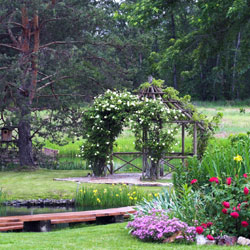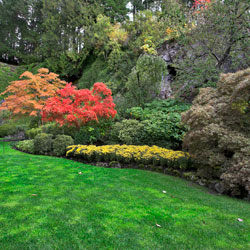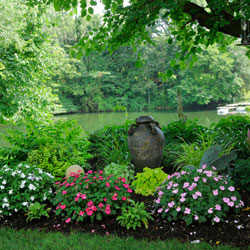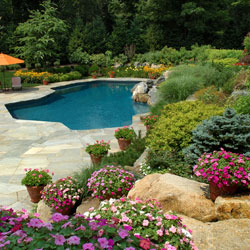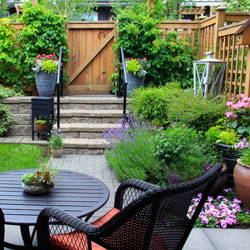No matter what you grow, your garden does not have to be a bland, predictable space. With careful planning, it is easy to create depth and character in the garden to reflect your personal flair and the enjoyment you find among your flowers, fruits, vegetables and herbs.
Understanding Your Foreground, Middle Ground and Background
Before planning your garden to enhance its depth and character, it is important to understand the different levels of space you have to work with. Your garden’s location, size and shape, as well as the overall layout, are part of these levels and can help you plan the best design to reflect your personal style.
- Foreground – The front of your garden, including borders, edging, fences, and entryways, as well as the first plants a visitor encounters when stepping into the space. Visually, this area is the welcome to your gardening or landscaping space.
- Middle Ground – The bulk of the garden or landscape, the center or middle areas. This will include most open spaces and the most heavily used parts of your garden, those that are accessed and admired the most.
- Background – The furthest, rear point of your gardening space, that provides a backdrop or endpoint for the design. This can include rear fences, walls or property borders and is the stopping point for your garden.
As you design your garden, each of these areas can be enhanced to create a more aesthetically pleasing space and an overall design rich in texture, color and creativity.
Depth in the Garden
Adding depth to the garden varies the space and makes the garden appear larger and more spacious. This can easily improve a narrow landscaping area or open up a small garden, and it maximizes growing space to allow for more plants. Great options to add more garden depth include…
- Tiers
Tiers, with taller plants at the back and shorter plants in the foreground, expand the space and give it a better scale. Taller plants can be added in corners or at the sides, with shorter plants filling in the center. Terraces, containers and raised beds can all create tiers. - Colors
Warm colors, such as red, yellow and orange, are bold and filling, and are best used at the front of the garden to create a welcoming flow. Cooler tones, such as greens and blues, are best in the background where they recede from the eye and give an illusion of greater depth and openness. - Contrasting Textures
Gardens and landscapes look smaller when they are uniform. Textural contrasts, however, break up sightlines and add more visual interest, enhancing depth. Opt for finer textures and airy plant structures to increase depth in the middle ground and background, while fuller, more compact textures are best in the foreground. - Plant Size
Positioning larger, taller plants in the background and reserving smaller plants for the foreground of your garden will enhance its depth. In small gardens, dwarf or miniature plant varieties immediately create greater depth and make the space seem more generous. - Secret Spaces
Adding a secret space will create depth as it draws the eye into the landscaping design and encourages more detailed examination of the area. Meditation niches, cozy benches or swings, or other places invite more interest in the garden and improve the depth. - Reflections
Just like a mirror creates more depth in a small room, reflections create more depth in a garden. Gazing balls, reflecting pools or mosaics are great options, but be sure there are no overly focused reflections that might damage nearby plants with excess glare. - Views
If your garden overlooks a dramatic view, such as a mountain range, ocean cliff or adjacent park, take advantage of that view for more personal garden depth. Avoid blocking the view, and instead frame it to draw the eye deeper into your space. - Vertical Gardening
Taking your garden vertical with climbing plants on a green wall, trellis or other support is a great way to increase depth and add more gardening space. Many vegetables and flowering vines can easily be trained to grow vertically.
Character in the Garden
Adding character to the garden personalizes it to reflect your unique style and flair. This adds a meaningful touch to your space, no matter how big or small it may be. Fun ways to give your garden more character include…
- Specimen Plants
Unusual plants create a focal point in your garden and draw the eye into the space. Even in a veggie garden or berry patch, an unexpected specimen can be an interesting feature. - Unique Shapes
Give your garden extra flair by incorporating unusual shapes, such as topiaries or plants with unexpected foliage or flower shapes. This extra texture will also enhance the garden’s depth. - Curves
Gardens and landscaping don’t need to follow straight lines. Help your landscape flow with curved garden rows, curving beds or other smooth, elegant lines. - Fill-Ins
Bare spaces cause a disjointed look in the garden, but you can easily fill in patches with extra herbs, flowers or ornamental grasses. This will add even more texture and interest to the area. - Welcomes
Welcome visitors to your garden with a fun, customized gate, quirky arbor or unique archway. This feature will draw the eye and encourage visitors to enter and enjoy the space. - Curbing
Get creative with curbing to border your garden area with personal flair. Instead of predictable options, choose colored curbing or add accents such as glass bottles or stepping stones. - Wildlife
Welcome wildlife to your garden to add life to the space. Bird feeders and baths, a butterfly, bee or toad house, or even a koi pond can bring movement and life to your garden. - Surprises
There’s always room in the garden for a surprise or two. It might be a hidden gnome peeking out at guests, scattered sunflowers that grow through other plantings, exotic edibles or flowers with potent perfumes to lure guests in to seek out the surprise.
You can add depth and character to your garden in many ways. If you aren’t sure just how to go about personalizing and enhancing your garden, ask our experts for help to create the garden of your dreams!

